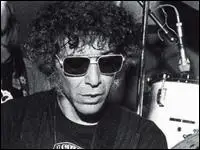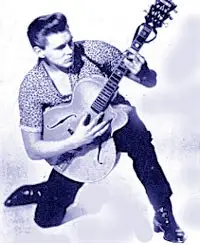AMERICAN EXPORTS
British audiences in the 50’s didn’t have much exposure to the Blues. During the 30s, some dance bands had played jazz and swing-based repertoire, but when American servicemen came to London in 1944, the clubs around ‘Rainbow Corner’ in the West-End were suddenly bouncing to the sound of ‘jump-Blues’. For the first time Young Brits heard this wild, good-time music and, like so many aspects of American culture, it was to prove the shape of things to come, but there was no local equivalent at the time.
Country Blues as American Folk music.
There was a revival of interest in British folk music in clubs and pubs all around the country after WWII, as live music made a comeback in the pre-TV age. In 1951 a nationwide tour of American folk performers, including Big Bill Broonzy, brought many new musical styles to Britain’s major concert halls. Big Bill played his ‘Chicago’ version of country Blues (which was looked on as an esoteric type of rural folk music) to appreciative audiences, and their reaction led to Big Bill returning several times over the next few years. Many future Blues players in Britain were turned on to Delta Blues through Big Bill’s work in those early tours.
By the mid-50s Rock’n’Roll was sweeping the new ‘teenage’ market, and this obviously had Blues roots too: Elvis covered Big Boy Crudup‘s songs and everyone latched on to Fats Domino and Little Richard‘s vibrant dance music coming out of New Orleans. Chris Barber, the trombonist and bandleader is the person most responsible for bringing the pure Blues form to the British public. In his jazz shows, he would play a ‘trad’ set with six players doing Dixieland numbers; a ‘big-band’ set with an 11- piece orchestra; and a Blues set with a smaller band which included Alexis Korner and Cyril Davies, sometimes backing Barber’s wife Otillie Paterson as she sang the songs of Bessie Smith and Memphis Minnie.
Muddy plays ELECTRIC Blues!

Alexis Korner
In the late 1957, the Musicians Unions of Britain and America were at war over work permits, and as a result American bands could not play in Britain. Singers were in a different Union, so Barber was able to bring in people like Sister Rosetta Tharpe, Sonny Terry and Brownie McGhee and Muddy Waters to play in front of his band. Chris was passionately evangelical about music, and he reckoned that playing with the experts would improve his and his band’s skills, as well as spreading the word about this powerful musical form by showcasing it’s finest performers. Muddy was probably the first person to play pure electric Blues in Britain and he really started something!

Billy Fury
By 1960 the American rock’n’roll scene was dying. Buddy Holly was dead, Elvis was in the army and Jerry Lee Lewis was in disgrace after marrying his 13-year-old cousin. The music scene in Britain was dominated by plastic imitations of American rockers, exemplified by Larry Parnes’ stable of young singers like Marty Wilde, Billy Fury and Tommy Steele. There were no Blues records in the shops. Radio was monopolised by the BBC, which regarded youth culture as an alien life-form, so the only outlet for American music were radio stations broadcasting from Continental Europe, like Radio Luxembourg and American Forces Network. Blues was not easy to find, on the radio, in record shops or played live.
Muddy plays the Blues on British TV;
Blues Clubs in every town.
Alexis Corner and Cyril Davies wanted to play Blues all night rather than being Barber’s ‘support act’, so in 1961 they formed Blues Incorporated with like-minded jazz players such as Charlie Watts, Jack Bruce, Dick Heckstall-Smith and Long John Baldry. Barber and his friend Harold Pendleton had just set up the Marquee Club in Oxford Street, and made Blues Incorporated the resident band. In 1962, Corner and Davies set up their own Ealing Blues Club which, became the ‘Cradle of British Blues’ as young players got up to jam with the house band and got a taste for performing. At least a dozen famous bands got started in that smoky cellar. The Ealing Club, the Crawdaddy in Richmond, the Manor House, Klooks Kleek in West Hampstead, Eel Pie Island and a handful of other pubs in London, quickly provided the venues where this new ‘British Blues’ took root, and in a few months there was a Blues Club in every town.
A young Jimmy Page plays some skiffle on British TV in 1957;
Skiffle and up-dated ‘Jug Bands’
Another British spin-off from ‘American Imports’ in the 50s was ‘skiffle’, an up-tempo folk genre which took it’s name and it’s ethos from the jug-bands that played around Memphis in the late 20s. Skiffle’s prime exponent was another ex-Barber player, Lonnie Donegan, who had several hit records including a cover of Lead Belly‘s ‘Rock Island Line’. Skiffle bands used cheap guitars, broomstick bass and washboard rhythms and as such were easy to get going, so a lot of young people realised that they could form their own bands. John Lennon, Mick Jagger, Jimmy Page, and Van Morrison all started out in skiffle groups. The energy from this self-starting ethos, admiration of the power of these newly discovered American forms and the fact that a growing audience would support this music played in their local pubs, were the elements that came together to fuel the ‘British Blues Boom’.
By 1963, The Rollin’ Stones, Pretty Things, Georgie Fame & the Blue Flames, Zoot Money, Manfred Mann, Them, The Blues Breakers, The Groundhogs, The Alex Harvey Band and a host of others were part of a huge groundswell of interest in the emerging live Blues and R’n’B scene.
And that was just the start!